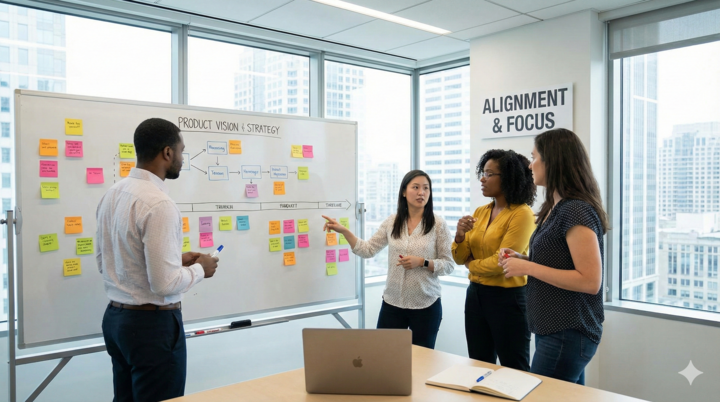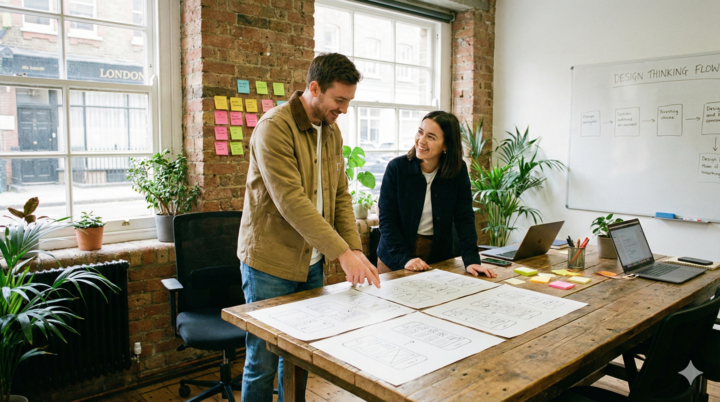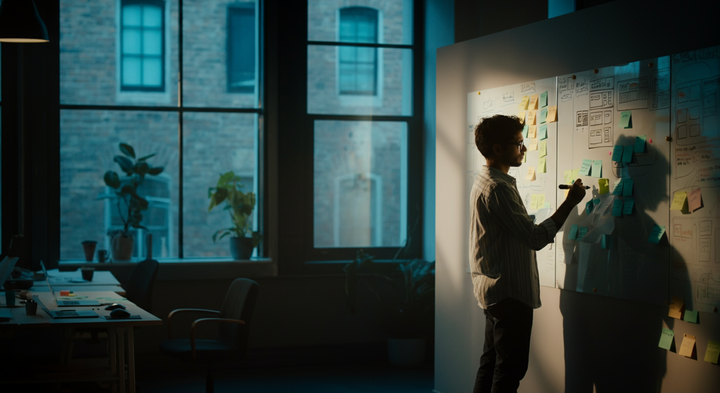Revolutionising User Experiences: The Future of UX Design and Research
The digital landscape is evolving at breakneck speed, and at its heart lies user experience (UX) design. As technology advances, so too does our understanding of user behaviour and the methods we employ to create intuitive, engaging interfaces.
This article explores the exciting future of UX design, exploring how emerging trends and cutting-edge research are reshaping the way we interact with digital products. We’ll examine the tools and techniques that UX designers are adopting to stay ahead of the curve, and consider the profound impact these changes will have on users and businesses alike.
This article is brought to you by Experience Haus – London’s leading provider of immersive, real-world courses in design, strategy, marketing and tech. Whether you’re looking to launch a new career in UX/UI design, upskill in product management, or explore the latest in AI, Experience Haus offers expert-led training to help you succeed. Explore our range of UX/UI courses to open up a world of exciting career possibilities.
The Evolution of UX Design: Past, Present, and Future
To understand where we’re headed, it’s crucial to appreciate where we’ve been. The field of UX design has come a long way since the early days of clunky interfaces and unintuitive navigation. In its infancy, UX design focused primarily on basic usability. The goal was simply to create interfaces that users could navigate without tearing their hair out.As technology improved and user expectations grew, so did the sophistication of UX design. Designers began to consider not just functionality, but also aesthetics and emotional engagement.
Today, UX design is a complex, multidisciplinary field that draws on psychology, sociology, and even neuroscience to create seamless, enjoyable user experiences. And the future? It’s looking more exciting than ever.
Key Milestones in UX Design History
The journey of UX design is marked by several pivotal moments. The introduction of the graphical user interface (GUI) in the 1980s revolutionised how users interact with computers, moving away from text-based commands to visual metaphors.
The rise of the internet in the 1990s brought new challenges and opportunities, as designers grappled with creating intuitive navigation for the vast web of information. The mobile revolution of the 2000s forced a rethink of design principles, as small screens and touch interfaces became ubiquitous.
Each of these milestones has shaped user expectations and pushed the boundaries of what’s possible in interface design. As we look to the future, we can expect even more dramatic shifts in how we interact with technology.
Current State of UX Design
Today’s UX designers are working at the cutting edge of technology, incorporating artificial intelligence and machine learning to create more responsive, personalised experiences. They’re also exploring the possibilities of augmented and virtual reality, blurring the lines between digital and physical worlds.
The focus has shifted from merely making interfaces usable to creating experiences that are truly engaging and delightful. Designers are paying more attention to micro-interactions, those small moments that can make using a product feel more intuitive and satisfying.
There’s also a growing emphasis on inclusive design, ensuring that digital products are accessible to users of all abilities and backgrounds. This holistic approach to UX design is setting the stage for even more exciting developments in the future.
Emerging Trends Shaping the Future of UX
As we peer into the crystal ball of UX design, several exciting trends are coming into focus. Personalisation is set to reach new heights, with interfaces adapting in real-time to individual users’ preferences and behaviours. Voice interfaces and natural language processing are becoming more sophisticated, potentially reducing our reliance on traditional graphical interfaces. Meanwhile, immersive and interactive experiences using VR and AR are opening up entirely new possibilities for how we interact with digital content.
Perhaps most importantly, we’re seeing a shift towards more ethical and sustainable design practices. UX designers are increasingly considering the long-term impacts of their work, from digital wellbeing to environmental sustainability.
The Role of Technology in Advancing UX Design
Technology and UX design have always been intertwined, each pushing the other forward. As we stand on the brink of major technological breakthroughs, it’s clear that the future of UX design will be shaped by these emerging technologies. From artificial intelligence to virtual reality, these tools are not just changing what we design, but how we design. They’re enabling us to create more intuitive, more personalised, and more immersive experiences than ever before. But with great power comes great responsibility. As these technologies become more prevalent, UX designers will need to grapple with new ethical considerations and challenges.
Let’s explore some of the key technologies that are set to revolutionise UX design in the coming years.
AI and Machine Learning in UX Design
Artificial intelligence and machine learning are already making waves in the UX design world. These technologies are enabling designers to create more personalised, adaptive experiences that learn and evolve based on user behaviour. AI-powered tools can analyse vast amounts of user data, identifying patterns and insights that human designers might miss. This can lead to more informed design decisions and more effective user experiences. Machine learning algorithms can also help automate repetitive tasks in the design process, freeing up designers to focus on more creative and strategic work. From generating layout options to optimising user flows, AI is becoming an invaluable assistant to UX designers.
Virtual and Augmented Reality: Reshaping User Interactions
Virtual and augmented reality technologies are opening up entirely new dimensions for UX design. These immersive technologies are changing the way users interact with digital content, blurring the lines between the physical and digital worlds. In VR, designers are creating fully immersive environments that users can explore and interact with in three dimensions. This presents exciting opportunities for fields like education, training, and entertainment. AR, on the other hand, overlays digital information onto the real world. This technology is already being used in applications ranging from navigation apps to virtual try-on experiences for fashion retailers.
The Internet of Things and UX Design
As our world becomes increasingly connected, UX designers are faced with the challenge of creating seamless experiences across a multitude of devices. The Internet of Things (IoT) is expanding the canvas for UX design beyond screens to include everything from smart home devices to wearable technology.
This shift requires designers to think beyond traditional interfaces. How do you design an intuitive user experience for a smart refrigerator or a voice-controlled lighting system? The key lies in creating cohesive ecosystems where devices work together seamlessly, anticipating users’ needs and reducing the cognitive load of managing multiple devices.
User-Centric Design: The Core of Future UX
As technology continues to advance, one principle remains constant: the need to put users at the centre of the design process. User-centric design isn’t just a buzzword; it’s the foundation of effective UX design, now and in the future.
The tools and techniques may change, but the goal remains the same: to create experiences that meet users’ needs, solve their problems, and bring them joy. As we look to the future of UX design, we see this principle being applied in increasingly sophisticated and nuanced ways.
Personalisation and Adaptive Interfaces
One of the most exciting developments in UX design is the move towards highly personalised, adaptive interfaces. Imagine a website or app that automatically adjusts its layout, content, and functionality based on your individual preferences and behaviour.
This level of personalisation is becoming possible thanks to advances in AI and machine learning. By analysing user data, these systems can create tailored experiences that feel intuitive and relevant to each individual user. However, with great power comes great responsibility. Designers will need to balance the benefits of personalisation with concerns about privacy and data security.
Emotional Design and User Psychology
As UX design matures, we’re seeing a growing emphasis on emotional design. This approach goes beyond mere usability to consider how a product makes users feel. By tapping into user psychology, designers can create experiences that not only meet functional needs but also resonate on an emotional level. This could involve using colour psychology to evoke certain moods, or designing micro-interactions that bring a smile to users’ faces.
The goal is to create products that users not only use, but love. And in a crowded digital marketplace, that emotional connection can be a powerful differentiator.
Accessibility and Inclusive Design
As our digital world expands, so too does the imperative to make it accessible to everyone. Inclusive design is no longer an afterthought; it’s becoming a fundamental principle of good UX design. This means considering the needs of users with different abilities, backgrounds, and contexts from the very beginning of the design process. It’s about creating flexible interfaces that can adapt to different user needs, whether that’s larger text sizes, voice controls, or simplified layouts.
The future of UX is one where digital experiences are truly accessible to all, regardless of ability or circumstance.
The Changing Role of UX Designers
As the field of UX design evolves, so too does the role of the UX designer. Today’s UX professionals need to wear many hats, combining skills from a variety of disciplines to create truly effective user experiences. Gone are the days when a UX designer could focus solely on wireframes and user flows. The modern UX designer needs to be part psychologist, part data analyst, and part futurist, able to anticipate and shape the digital experiences of tomorrow.
Multidisciplinary Skill Sets
The UX designers of the future will need to be versatile and adaptable, comfortable working across a range of disciplines. This might include skills in areas like data analysis, cognitive psychology, and even ethical philosophy. As technology becomes more complex, UX designers will also need to develop a deeper understanding of the technical aspects of the products they’re designing for. This doesn’t mean becoming full-stack developers, but rather having enough technical knowledge to effectively collaborate with engineering teams and push the boundaries of what’s possible.
Collaboration with AI and Automation
As AI and automation tools become more prevalent in the design process, UX designers will need to learn how to effectively collaborate with these technologies. This might involve using AI-powered design tools, interpreting data from machine learning algorithms, or designing the user experience for AI-driven products. Rather than replacing human designers, these technologies are likely to augment their capabilities, allowing them to work more efficiently and make more informed decisions. The key will be learning how to harness these tools effectively while still maintaining the human touch that’s so crucial to good design.
Ethical Considerations in UX Design
As digital products become increasingly integrated into our lives, UX designers are finding themselves grappling with complex ethical questions. How do we design products that respect user privacy? How can we create engaging experiences without contributing to digital addiction?
These ethical considerations are becoming a crucial part of the UX designer’s role. It’s no longer enough to create experiences that are merely usable and enjoyable; they must also be responsible and sustainable.
The Impact of UX Design on Business and Society
The influence of UX design extends far beyond the digital products we use every day. As our world becomes increasingly digital, the principles and practices of UX design are shaping business strategies, social interactions, and even the way we perceive and interact with the world around us. From e-commerce to education, healthcare to entertainment, effective UX design is becoming a key differentiator for businesses across all sectors. But its impact goes beyond the bottom line, influencing social behaviours and cultural norms in profound ways.
UX Design as a Competitive Advantage
In today’s crowded digital marketplace, good UX design can be the difference between success and failure. Companies that invest in creating intuitive, enjoyable user experiences are seeing tangible benefits in customer satisfaction, loyalty, and ultimately, profitability.
This goes beyond just having a slick website or app. It’s about creating holistic experiences that meet users’ needs across all touchpoints, from first contact to long-term engagement.
Societal Implications of Advanced UX Design
As UX design becomes more sophisticated, it’s not just changing how we interact with technology, but how we interact with the world and each other. Social media platforms, designed to be engaging and addictive, have reshaped social norms and communication patterns.
Looking ahead, technologies like VR and AR have the potential to blur the lines between physical and virtual spaces even further. As UX designers, we have a responsibility to consider the broader implications of our work and strive to create experiences that enhance, rather than detract from, human connection and wellbeing.
Conclusion: Embracing the Future of UX Design
As we’ve explored throughout this article, the future of UX design is bright, complex, and full of possibilities. From AI-powered personalisation to immersive VR experiences, the tools and techniques at our disposal are more powerful than ever before. But with this power comes great responsibility. As UX designers, we have the opportunity – and the obligation – to shape the digital future in ways that benefit users and society as a whole.
By staying curious, embracing new technologies, and always keeping users at the heart of what we do, we can create a future where technology enhances our lives in meaningful and positive ways. The future of UX design is in our hands – let’s make it a good one.




